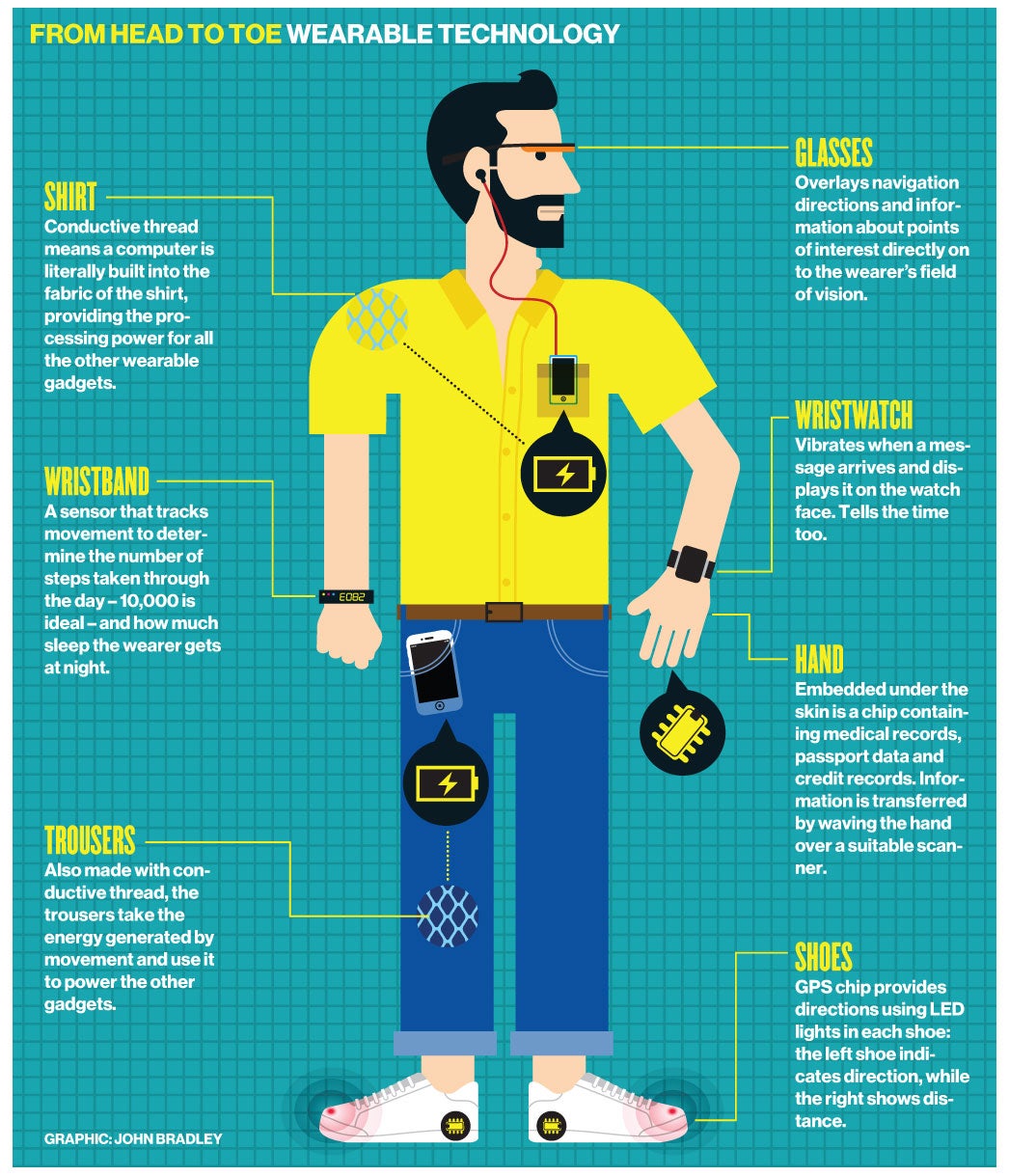Wearable computing is here already: How hi-tech got under our skin
George Osborne is a recent convert. Next, like retina displays, it will soon be implanted into our bodies

The revelation that George Osborne has begun using Jawbone Up, the activity-tracking wristband that monitors how much you move during the day and whether you sleep enough at night, caused some mirth in Westminster last week.
But the Chancellor isn’t the only one joining in the wearable technology trend. Marissa Mayer, CEO of Yahoo!, is giving Up wristbands to its 11,000 employees, and tech industry observers foresee a time when the activity tracker is issued to new employees with their laptop and smartphone.
While wearable computing isn’t new, this year it’s everywhere. Activity trackers like Jawbone Up and Fitbit Flex are increasingly prominent. Google Glass, the computer-enhanced eyewear with in-built camera, speaker and internet connectivity has a growing profile. And smartwatches, such as the Pebble, are moving smartphone features to a wristwatch.
Juniper research says that 15 million wearable computing gadgets will be sold this year and expects that to increase to 70 million by 2017. If Apple’s rumoured iWatch appears, then expect growth to hasten.
Wristbands, watches and glasses are just the beginning. Next-generation wearables will be part of the fabric of our clothes – literally. London-based CuteCircuit has developed a mobile phone dress with an antenna in the seam and the SIM card in the label. Artist and designer Dominic Wilcox’s No Place Like Home shoes use GPS and LED lights to give directions.
These are concepts, not commercial products, but compared with what’s coming, they seem crude. Research published in 2011 by a team of scientists from Italy, France and the US explored the possibilities of using conductive thread – cotton coated in nanoparticles and polymers – to form transistors and circuits. Instead of wearing a dress with a computer built-in, your dress will be the computer.
Sabine Seymour, founder of Moondial, an agency that develops and consults on wearables, says: “We forget that we constantly wear a textile on our body. If we use that assumption that a consumer is covered everyday, we have a fantastic surface where we can embed a lot of functionality.”
She foresees smart clothes that change colour, regulate our temperature, charge the gadgets we carry and don’t need to be washed. Wearable computers and smart clothes are fine, but what about simply having the technology surgically implanted in your body? Instead of glasses, imagine if your retina had a display built-in. Consider an activity tracker implanted in your foot, or a tooth-filling sensor that vibrates when you have a message. Embedded technology has been used in medicine for decades. Pacemakers and cochlear implants were first developed in the 1960s.
More recently, work has begun on sensors that can be swallowed to monitor the effect of medical treatment and disposable monitoring patches that can be attached to the body. There is a difference between medical implants, which are often the best way to deal with a health problem, and lifestyle implants – but there’s no reason to think there won’t be demand for the latter. Many people already modify their bodies with tattoos, piercings and cosmetic surgery.
Kevin Warwick, professor of cybernetics at the University of Reading, has been experimenting on himself for more than a decade. In 1998, he had a silicon chip implanted in his arm that controlled the door and the lights in his laboratory. A second experiment, four years later, let him remotely control a prosthetic hand.
This year, Rich Lee, a 34-year-old American, had magnets implanted in the tragus – the small protuberance in front of the ear canal – that act as speakers when combined with a coil necklace. In 2011, Trevor Prideaux, 50, had a smartphone embedded in his prosthetic arm, making it easier to use the device with only one hand.
It will be some time before such modifications become mainstream, particularly because nobody knows what the long-term health effects of implants might be. On a practical level, returning a broken smartphone is straightforward; “returning” a broken implant would be trickier.
For now, there are other concerns about wearable technology. The US anti-Google Glass campaign, Stop The Cyborgs, provides downloadable stickers reading: “No surveillance devices”. Some critics warn that Google Glass facial recognition software could track people without their knowledge. Google currently doesn’t permit such software but a determined developer could get around that.
Data security is a potential worry, too. What happens to all that information about your exercise and sleep habits? What if your health data was sold to a third party, such as an insurance company? Could an employer discriminate against a worker with an “unhealthy” lifestyle?
Finally, there’s the problem of compulsion. Dr Larry Rosen, a professor at California State University and an expert in the psychology of technology, says: “In our studies, the typical teen and young adult checks his or her smartphone every 15 minutes or less and if they can’t check as often as they like they get anxious. This anxiety then drives the need to check in to reduce the anxiety which then begins to build again.” The more immediate nature of wearable technology could make this problem worse, he says.
But these concerns aren’t exclusive to wearables; they apply equally to smartphones and other technology. For most people, the benefits – helping us to understand ourselves better and bringing us information in a less distracting way – will outweigh the risks, as they have with smartphones. The technology will advance regardless and George Osborne’s wristband will seem quaint when our children are confronted by the first cyborg Chancellor.
Shane Richmond’s ebook ‘Computerised You: How Wearable Technology Will Turn Us Into Computers’ will be out as a Kindle Single next month.
Join our commenting forum
Join thought-provoking conversations, follow other Independent readers and see their replies
Comments
Bookmark popover
Removed from bookmarks